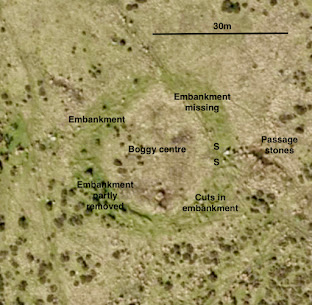It's intriguing that the two ring cairns on Waun Mawn are either unfinished or else seriously damaged -- and maybe both........
The biggest one, which I call the Gernos Fach ring cairn, at SN 07708 34535, is not a very spectacular feature, since the embankment is generally only about 50 cms high. That may be, of course, because it is very old and degraded. But it's about 30m in diameter, and is very easy to spot on satellite images. The embankment is grassy and dry, and the centre is boggy with reeds here and there. It may be that only two thirds of the embankment was completed, since there is no trace of it in the NW segment. It's made of dolerite bloulders and stones, as distinct from the Cnwc yr Hydd ring cairn which is made largely of meta-mudstone and shale rubble.
There is a clear entrance on the eastern edge of the feature, with one stumpy standing stone apparently in position and another much larger stone that has almost fallen over. There may be an entrance "passage" to the east of these stones, with a further six boulders roughly in two lines, and with a seventh stone -- probably fallen -- in the centre of the "passageway".
The southern and south-western sections of the embankment have clearly been excavated and partly removed. Why, and when?
The ring cairn to the SE of the Cnwc yr Hydd summit cairn (at SN08321 34446) is a smaller feature, only about 11m in diameter, with an embankment made of meta-mudstone and shale fragments and an embankment that varies between 50 cms and 1m high. There is a distinct hollow in the centre. Most of the ring is complete, but in the northern segment there are traces of two overlapping circular features, each with a diameter of c 4m. One of these is quite prominent, and may be a remnant of a hut circle. But there has been a lot of debris removal from this northern segment, and the cutting shows up quite clearly on the satellite image.
PS. I'm quite intrigued by the fact that neither of these ring cairns / circular enclosures is mentioned in the RCAHMW or Coflein records. Other features on Waun Mawn and Banc Du are mentioned, but not these......... in spite of them being quite prominent and easy to spot on satellite imagery.



No comments:
Post a Comment